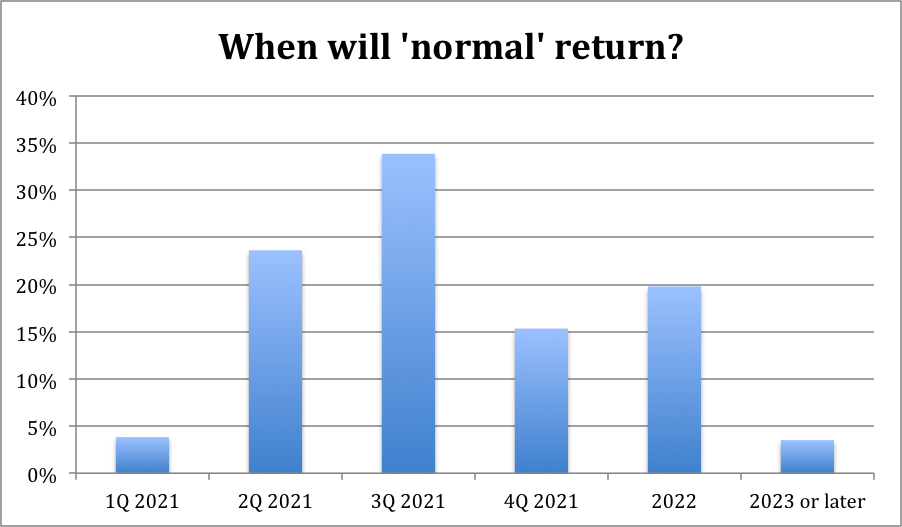
A strong majority of nursing home leaders say they think that “all normal activities,” such as regular group dining, full visitations and trips to the outside community, will be able to take place again by the end of summer, according to a new McKnight’s Long-Term Care News survey.
The national public health emergency caused by COVID-19 effectively eliminated all such activities starting in March, when the coronavirus pandemic was declared in the U.S. Visitation policies and some dining activities were relaxed in many places over the summer before a recent resurgence of infections and deaths shut them down again this fall.
The poll of more than 300 nursing home owners, administrators and top nurse managers also revealed that leaders are almost evenly split as to whether they are “more optimistic” (39%) or “less optimistic” (37.4%) about “prospects for the industry” under an incoming Biden administration. Nearly 24% said they thought prospects “are about the same” as under the current administration.
Survey results reflect answers from 313 McKnight’s Long-Term Care News readers who responded to solicitations emailed from Dec. 7-12. Additional findings of the “McKnight’s LTC News 2021 Outlook” Flash Survey will be published this week.
Most respondents chose “third quarter of 2021” (34%) for when activities at the nation’s nursing homes would reflect “normal” conditions again. That was followed by “second quarter 2021” (24%). Added together with 4% who chose “first quarter of 2021,” it amounts to 72% believing that by the end of September, nursing home daily routines could largely reflect pre-pandemic conditions.
After a dip in popularity for “fourth quarter of 2021” (15.3%), expectations for “normal” to resume rose to 19.8% for the option “2022,” while 3.5% thought it would take until 2023 or later.

While administrators and nurse managers were largely aligned with the percentages stated above, the subgroup of owners and C-suite survey respondents took a more conservative stance. The top execs still felt “third quarter of 2021” (36.5%) was the most likely timetable, but 21.1% said “normal” would not return until 2022 and 19% said the fourth quarter of this year.
“The vaccine is going to be the game-changer,” said Bill McGinley, executive director of the American College of Health Care Administrators. He noted that many industry insiders had predicted that fall of 2021 could mark a return to some semblance of normalcy — but that was before extreme vaccine advances were announced.
“By the middle of summer or end of summer, most of the country’s nursing home residents and staff should have all the vaccine they need,” McGinley noted. “I don’t think it will make all issues go away — census and staffing will still be big. Those will take a long time.”
McKnight’s has previously reported that numerous top nursing home operators and chain execs have predicted that census levels may take up to two years to return to pre-pandemic levels, while a full move upward again might not start until summer of 2021.
The success of vaccine distribution will be the driving indicator for provider equilibrium, agrees Amy Stewart, RN, the top nursing executive with the American Association for Post-Acute Nursing.
“They’re saying vaccines won’t roll out for everybody until later in 2021. If that’s the case, I could see 2022” for a return to normal routines, Stewart said.
Numerous academic researchers have established links showing that the levels of COVID-19 infections inside long-term care facilities are tied to the levels in surrounding geographic areas in general.
“For rural areas, it’s going to be tough,” Steward added. “I can see where (normalcy) gradually is starting in the third or fourth quarter. But if I’m betting on it, I’d think things are not back to normal until 2022. But I hope I’m wrong.”
Biden uncertainty
The likely effects of life under a Biden administration are no less clear. Respondents were divided, much like the country as a whole in the Nov. 3 general vote. Biden, however, again received a generally more optimistic nod — except with those in the administrators subgroup.
That sector showed an even 40% were “less optimistic” about potential Biden administration policies, while 38% were “more optimistic” and 22% said they expected “about the same” as under the current administration.
Top LTC execs were most favorable about a change in the White House. Owners and C-suiters were 40% “more optimistic” while just 31% tabbed “less optimistic,” and 29% thought prospects would be about the same.
McGinley pointed out that Democrats are seen as more likely to put in more regulations while the current Republican administration has often praised its own efforts to lighten regulatory burdens, a common aim of the party. Biden has given many providers professional pause by including in his campaign platform vows to toughen the survey process and resurrect an Obama-era ban on admissions arbitration clauses. He also is seen as more pro-labor.
“In general terms, and it’s not really a political statement, it’s just a fact of life, that businesses of all stripes do better under Republicans than Democrats,” McGinley said. “Democrats are more likely to put in more regulations with hopes of improving quality. I wouldn’t be more surprised to see more regulations coming. I would (also) be more of an optimist that a Biden administration would not be as heavy-handed with things like fines and punishments and sanctions.”
Watch for Part II of the “McKnight’s LTC News Outlook 2021” Flash Survey results on Thursday.



